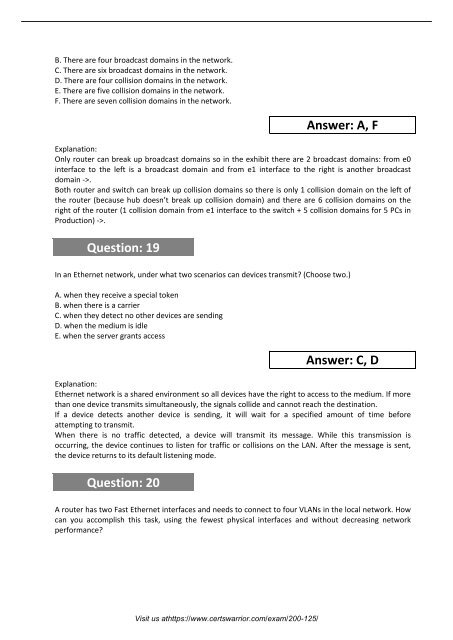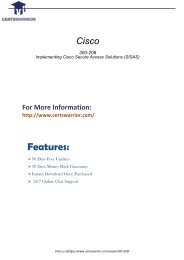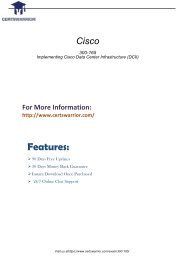200-125 Certification
Get high success rate in 200-125 Certification Exam with our exam PDF questions answers prepared by the authorized persons of Information Technology industry. For more info please visit here: https://www.certswarrior.com/exam/200-125/
Get high success rate in 200-125 Certification Exam with our exam PDF questions answers prepared by the authorized persons of Information Technology industry. For more info please visit here: https://www.certswarrior.com/exam/200-125/
Create successful ePaper yourself
Turn your PDF publications into a flip-book with our unique Google optimized e-Paper software.
B. There are four broadcast domains in the network.<br />
C. There are six broadcast domains in the network.<br />
D. There are four collision domains in the network.<br />
E. There are five collision domains in the network.<br />
F. There are seven collision domains in the network.<br />
Answer: A, F<br />
Explanation:<br />
Only router can break up broadcast domains so in the exhibit there are 2 broadcast domains: from e0<br />
interface to the left is a broadcast domain and from e1 interface to the right is another broadcast<br />
domain ->.<br />
Both router and switch can break up collision domains so there is only 1 collision domain on the left of<br />
the router (because hub doesn’t break up collision domain) and there are 6 collision domains on the<br />
right of the router (1 collision domain from e1 interface to the switch + 5 collision domains for 5 PCs in<br />
Production) ->.<br />
Question: 19<br />
In an Ethernet network, under what two scenarios can devices transmit? (Choose two.)<br />
A. when they receive a special token<br />
B. when there is a carrier<br />
C. when they detect no other devices are sending<br />
D. when the medium is idle<br />
E. when the server grants access<br />
Answer: C, D<br />
Explanation:<br />
Ethernet network is a shared environment so all devices have the right to access to the medium. If more<br />
than one device transmits simultaneously, the signals collide and cannot reach the destination.<br />
If a device detects another device is sending, it will wait for a specified amount of time before<br />
attempting to transmit.<br />
When there is no traffic detected, a device will transmit its message. While this transmission is<br />
occurring, the device continues to listen for traffic or collisions on the LAN. After the message is sent,<br />
the device returns to its default listening mode.<br />
Question: 20<br />
A router has two Fast Ethernet interfaces and needs to connect to four VLANs in the local network. How<br />
can you accomplish this task, using the fewest physical interfaces and without decreasing network<br />
performance?<br />
Visit us athttps://www.certswarrior.com/exam/<strong>200</strong>-<strong>125</strong>/
















